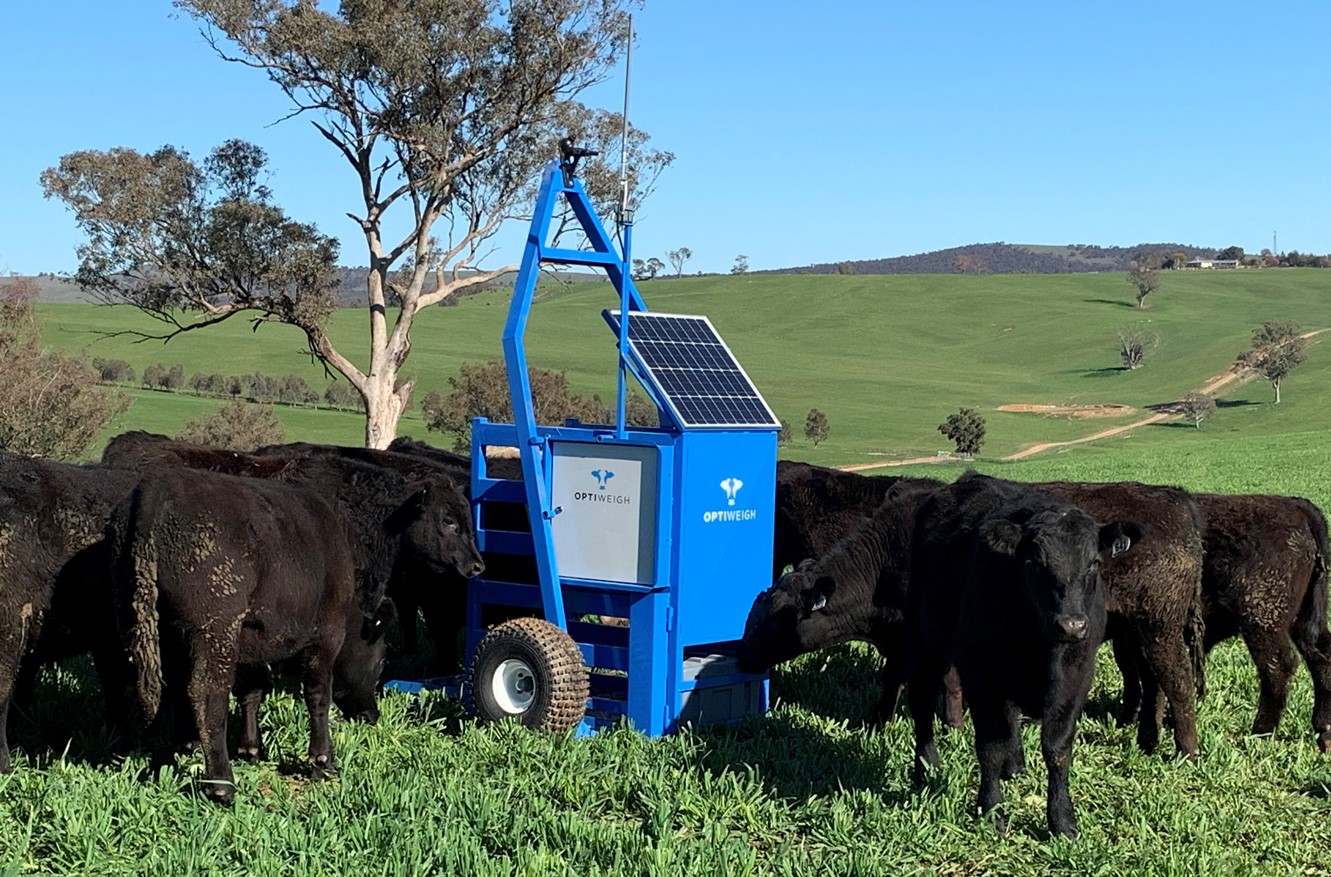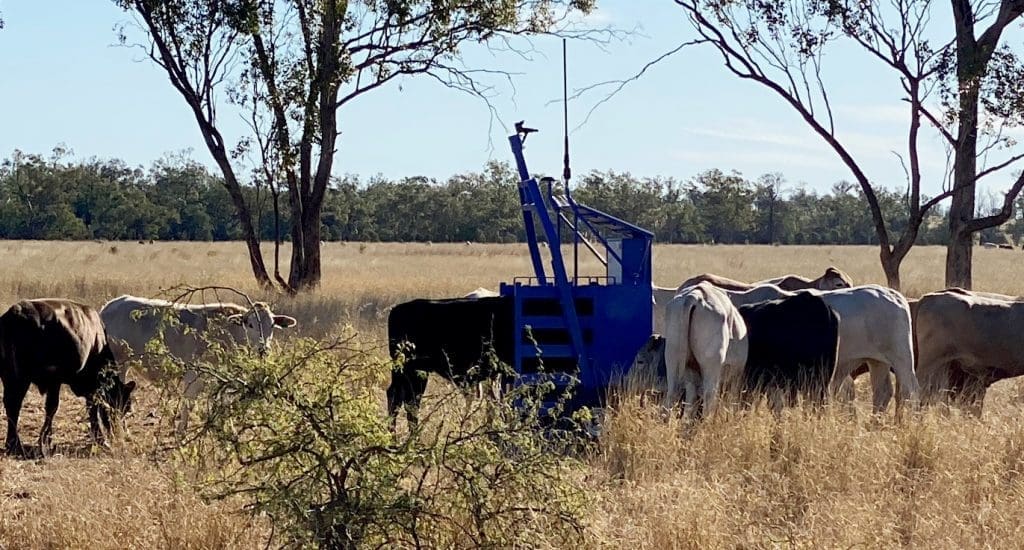
A REMOTE cattle weighing system that enables in-paddock weighing and remote monitoring of livestock is allowing producers to monitor animal and paddock performance, reduce the expense of mustering and yard weighing and optimise exit weights to meet market specifications.
The self-powered system records accurate weights for individual animals.at regular intervals as they graze in a paddock without the cost, time and live-weight loss associated with yarding and manually weighing cattle
The Optiweigh scale unit and remote monitoring system was officially launched late last year and is now available across Australia.
Set up
The scales are mounted on a two-wheel axle with a swing-up tow bar which puts the scales at ground level when the unit is in use in the paddock. The system is portable and easily towed from one paddock to another behind a ute, ATV or side-by-side. It will also fit on a trailer for road transport.
The scale unit is solar-powered, with battery back-up, and has an NLIS panel reader and antenna for data transfer to the Optiweigh website. The website is updated hourly with NLIS identification and weights recorded. From this information, different reports are created that can be viewed and downloaded on any device with internet access.
Inside the scale unit, there is an area to house an attractant or lick block to entice individual animals to stand with their front feet on the unit and be weighed.
The system manufacturers have found the best all-round attractant to use is a molasses block, as it seems to give the best chance of maximising the number of weight records across a range of environments.
In some situations, a salt block may be preferable as it will last longer. But using salt as an attractant generally gives fewer records unless used in an intensive grazing system. Producers are encouraged to try other blocks or dry licks as well, to see what works best to entice the cattle to come up to and onto the unit. It also helps to place the scale unit near a watering point.
How it works
Liveweights of individual animals are obtained by the unit weighing the two front feet the animal as it eats the attractant. It then uses algorithms to generate whole-body liveweights.
The accuracy of front feet weighing is well established following US research over the past decade. Optiweigh has further developed its own conversion algorithms after extensive research and trialling on different animal types and in different environments in Australia.
These algorithms have also been independently verified in trials conducted by NSW DPI in conjunction with CSIRO. Regular accuracy checks and comparisons have found the mob average of a mob weighed through the yards and one weighed using the Optiweigh system will be within 10kg of each other.
In most mobs, it is rare for all animals to be weighed by the Optiweigh system, because naturally some animals will be more eager to step onto the scale on order to access the attractant than others. The numbers weighed also depends on the size of the mob, size of the paddock and length of the weighing session. Generally, for mobs of less than 100 animals, 40-80 animals will be weighed. The number weighed by the Optiweigh system does not increase proportionately as mob size increases, unless the system is used in a very intense situation such as cell grazing or in a feedlot.
The higher the weight range of a mob, the more animals that need to be weighed to get an accurate average using the Optiweigh system. The length of time needed to get enough weight records for 10kg accuracy largely depends on paddock size. Once a mob is familiar with the Optiweigh unit (usually within a week), taking it away and then bringing it back to the paddock is a good way to get a lot of records quickly. Under extensive grazing conditions, sessions of 1-2 weeks are usually required to get adequate weight records. Longer sessions will eventually increase the number of animals weighed, but only gradually.
Data collected
To begin a weighing session, producers log into the Optiweigh website to give the session, mob and paddock name, and to tell the system when the session starts. The unit will then send NLIS and associated weight data to the website hourly. The producer can then view and download a variety of reports at any time, including charts showing the number of animals weighed daily and their weights, the weight distribution of the mob (in 25kg weight bands), and the average weekly weights for animals during the current and all previous sessions.
A daily email is also available that summarises the activity on the Optiweigh unit over the previous 24 hours, including the number of weight records, average mob weight and maximum and minimum weights recorded.
Costs and options
The cost of Optiweigh scale unit and communication package (including an annual subscription fee) depends on the connectivity method used. The communication package includes real-time reporting and data analysis, historical tracking, service and support and software updates.
If there is no reception at the time a weight is recorded, data will be stored on a USB memory stick in the scale unit. The data will be sent to the website once the unit does come into communication range. Alternatively, the USB stick can be removed, inserted into a computer and the weight data emailed to Optiweigh for processing and uploading.
Producer experience
Will and Kate Drury run a cattle backgrounding and dryland farming operation near Meandarra in south-east Queensland. Cattle come in at 300kg liveweight and are extensively grazed on brigalow/belah country until they reach a target weight of about 450kg. They are then sent to the Drury’s feedlot at Condamine to be fed for 100 days.
The Drurys decided to use the Optiweigh system as part of their backgrounding operation after hearing about it from a friend at Roma who was using it with great results.
“We thought it would be a great way for us to really see how our cattle were performing in each paddock,” Mr Drury explained.
“By getting a regular and accurate mob weight average, we would have a better idea of when the cattle would be ready to go to the feedlot. We would also see when the cattle needed supplements or trace elements, as is often the case in winter when pasture hays off after a few frosts.”
The Drurys started using the Optiweigh system (with cellular connectivity) in the middle of June last year, when they were backgrounding young, predominantly crossbred steers and heifers.
“We immediately took it out to a mob of 970 steers we had in an 800ha paddock,” Kate Drury said.
“We placed a molasses-based block in the tub of the unit and within half an hour or so we had a beast on it. I think on the first day we had 15 records and within a few days we had up to 90 records in one day.”
To date, the Drurys have had no problems with either the set up or use of the Optiweigh equipment and data recording service. They have been using molasses-based blocks as the attractant, replaced every 2-3 weeks. They have found the Optiweigh system to be a great tool for assessing how cattle are performing while reducing the labour cost and time spent mustering that is usually associated with weighing cattle.
“When we first began using the system, we sent our induction weights to Anthony and he was able to put them on the Optiweigh website,” Will explained.
“Now we can see the exact weight of each beast when it arrived, their current weight (or the mob average) and follow their weight gain each week if individual animals regularly go on the unit.
“Some animals only go on the unit once during a session while others are always getting on it. The only potential problem I could see is if the attractant used wasn’t attractive enough. But cattle are inquisitive creatures and they generally want to have a look, sniff and a lick so they tend to go on the unit at least once.
Since receiving the unit in June, the Drurys moved it six times within three main mobs. The mobs have all been larger, with 900-1000 head in each.
The Optiweigh system has given us a great indication of mob average. Over the past two weeks we have mustered and weighed these cattle and each mob average was within 5kg of what the Optiweigh had recorded,” Mrs Drury said.
The Drurys plan to use data from the Optiweigh unit to compare different pastures and supplements.
“We can compare one paddock to another and see the benefits depending on what improvements and developments have been done,” Mrs Drury said.
“This will help us construct more accurate feed budgets as we will have data showing what each paddock is capable of.
“We will also compare the performance of the different breeds and genders of the cattle we background. The proof of weight gains and animal performance will also open opportunities for agistment marketing should we decide to go down that path in the future.
The Drurys may even set up an Optiweigh system in their feedlot, to monitor animal weight gain over the 100 or so days they are on feed.

Backgrounder steers attracted to the molasses blocks use in the Optiweigh unit on Will and Kate Drury’s Meandarra property
Source: Kondinin
